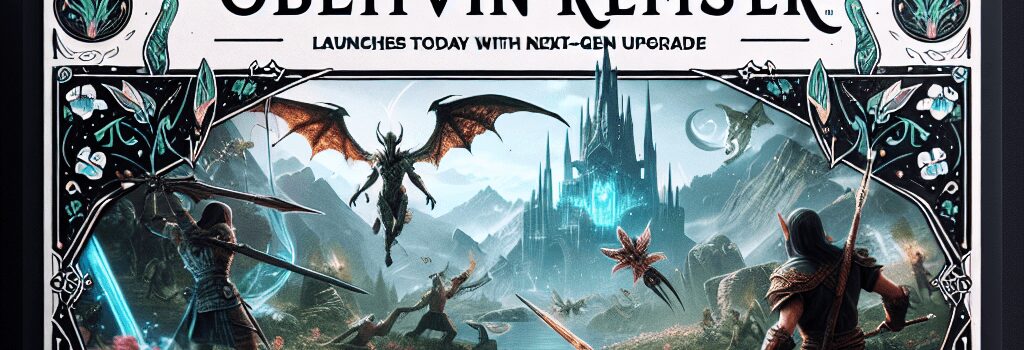Oblivion Remaster Launches Today with Next-Gen Upgrade

Surprise Launch and Live Reveal
In an unannounced live stream on Twitch and YouTube, Bethesda Game Studios and Virtuos unveiled The Elder Scrolls IV: Oblivion Remastered—available today on PC (Steam), PlayStation 5, and Xbox Series X|S (also on Game Pass) for $50. This edition marries Bethesda’s proprietary Creation Engine for gameplay logic with Unreal Engine 5’s state‑of‑the‑art rendering pipeline. A day‑one update (v1.0.2) addresses HDR calibration, audio desyncs, and memory leak fixes, ensuring a smoother out‑of‑the‑box experience.
Engine Architecture and Technical Overhaul
- Rendering: Built on Unreal Engine 5.1, featuring Lumen dynamic global illumination, Nanite virtualized geometry for high‑polygon asset streaming, and hardware‑accelerated ray tracing.
- Gameplay Logic: Core systems—AI, quest scripting, physics, and collision—still run on Creation Engine 2, now containerized in a dedicated process to reduce hitching and memory fragmentation.
- Cross‑Platform API Support: Full DLSS 3, FSR 2.1, and Intel XeSS upscaling options; Vulkan on PC and DirectX 12 Ultimate on consoles.
- Audio Pipeline: Spatialized audio via FMOD with real‑time reverberation and occlusion, replacing the original stereo cues.
Integrating two engines required a custom inter‑process communication (IPC) layer with shared memory buffers for synchronized state updates. This hybrid approach preserves mod compatibility with existing *.esm and *.esp files while delivering next‑gen visuals.
Gameplay System Revisions
- Leveling System: A blended model combining Oblivion’s skill‑based advancement with Skyrim’s milestone perks—players gain both attribute points and curated perk trees.
- AI Packages: NPC routines now leverage Behavior Trees in UE5, enabling more lifelike schedules and richer emergent behavior.
- Weapon & Armor Balancing: Recalculated DMG vs. DFR metrics based on community telemetry; damage falloff and armor durability have been re‑parameterized to avoid power‑level spikes.
- Classic Systems Retained: Persuasion minigame and lockpicking mechanics remain intact, with optional quality‑of‑life toggles for faster success rolls.
This revamp addresses longstanding critiques of the original’s “level‑lock” grind by introducing a dynamic XP table and a soft cap system that encourages continuous progression without exploit farming.
Visual Upgrades and Performance Metrics
- 4K/60FPS Target: Consoles default to 4K dynamic resolution at 60 FPS; PC can unlock framerates with manual resolution scaling.
- Character Models: Over 200 unique NPC faces re‑sculpted in ZBrush, retopologized for Nanite, and re‑rigged with full facial blend‑shape animations.
- Environmental Effects: Volumetric fog, real‑time water caustics, and particle FX drive a lifelike atmosphere in the Shivering Isles and Imperial City.
- UI & UX: Completely redesigned HUD, inventory, and map interfaces in UE5’s UMG toolkit—retaining the familiar parchment motif while scaling to 4K/UHD displays.
Early benchmarks on an RTX 3080 Ti and Ryzen 9 5900X hit 120 FPS at 1440p with maxed settings, while a PS5 Digital Edition hovered at 55–65 FPS in urban environments.
Modding and Community Tools
The Remaster ships with an updated Creation Kit compatible with existing mods. Bethesda has also released a UE5 asset pipeline plug‑in enabling modders to import custom meshes, materials, and Blueprint scripts directly from the Unreal Editor. Nexus Mods support went live hours after launch, and community creators are already optimizing texture packs and scripting new questlines using the hybrid engine stack.
Industry Perspectives and Expert Insights
Virtuos Paris director Jean‑Luc Marcel commented, “Integrating Unreal’s renderer with Creation Engine’s gameplay demanded rigorous profiling and memory management. We built custom allocators and thread pools to hit our performance targets.” Meanwhile, Unreal Engine lead technical artist Maria Cortez highlighted the use of UE5’s virtual shadow maps and hardware motion blur to modernize fast traversal and combat sequences, stating, “We wanted protagonists to feel grounded at 60 FPS without losing the franchise’s signature presentation.”
With The Elder Scrolls VI still in pre‑production and no new mainline entry since 2011, this remaster fills a decade‑plus drought for fans—offering both nostalgia and cutting‑edge tech.